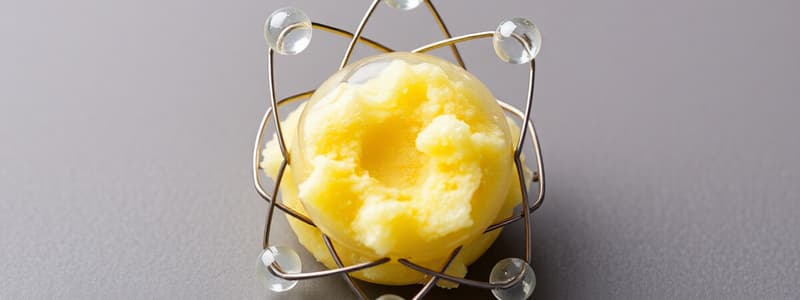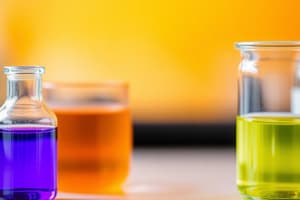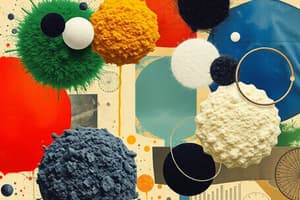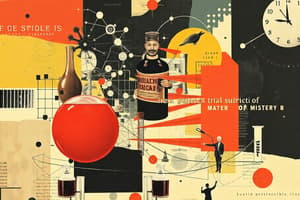Podcast
Questions and Answers
What are the three states of matter?
What are the three states of matter?
- Solid, Liquid, Gas (correct)
- Gas, Plasma, Energy
- Liquid, Gas, Foam
- Solid, Plasma, Liquid
Boiling and evaporation are the same processes.
Boiling and evaporation are the same processes.
False (B)
What is the term for a mixture that has a uniform composition throughout?
What is the term for a mixture that has a uniform composition throughout?
homogeneous mixture
An atom is made up of protons, neutrons, and ______.
An atom is made up of protons, neutrons, and ______.
Which of the following statements about isotopes is correct?
Which of the following statements about isotopes is correct?
Match the type of bonding with its characteristic:
Match the type of bonding with its characteristic:
When elements form ionic compounds, they gain or lose electrons to achieve a full outer shell.
When elements form ionic compounds, they gain or lose electrons to achieve a full outer shell.
What rule explains the tendency of atoms to achieve eight electrons in their outer shell?
What rule explains the tendency of atoms to achieve eight electrons in their outer shell?
Flashcards
Compound
Compound
A pure substance made up of two or more elements chemically combined in a fixed ratio. For example, water (H₂O) is a compound made up of hydrogen and oxygen.
Element
Element
A pure substance that cannot be broken down into simpler substances by chemical means. It's made up of only one type of atom. For example, gold (Au) is an element.
Mixture
Mixture
A substance consisting of two or more substances mixed together, but not chemically combined. Components can be separated by physical means. For example, salt water is a mixture of salt and water.
Homogeneous Mixture (Solution)
Homogeneous Mixture (Solution)
Signup and view all the flashcards
Heterogeneous Mixture
Heterogeneous Mixture
Signup and view all the flashcards
Atom
Atom
Signup and view all the flashcards
Molecule
Molecule
Signup and view all the flashcards
Physical Change
Physical Change
Signup and view all the flashcards
Study Notes
Semester 1 Topics - MYP Chemistry
-
Unit 1: Matter
- Topic 1: Classification of Matter
- Matter classified by state (solid, liquid, gas)
- State changes (melting, freezing, boiling, evaporation)
- Heating curves
- Classification by components (pure substance vs. mixture)
- Pure substance (element vs. compound)
- Mixture (homogeneous vs. heterogeneous)
- Component comparison (element vs. atom vs. compound vs. molecule)
- Topic 2: Separation Techniques
- Chromatography techniques
- How to use Rf values to identify substances
- Understanding Rf calculation
- Chromatography procedure
- Topic 1: Classification of Matter
-
Unit 2: Atomic Structure
- Topic 1: History of the Atomic Theory
- Development of atomic models
- Scientists involved in atomic theory development
- Topic 2: Structure of the Atom
- Subatomic particles (protons, neutrons, electrons)
- Atomic number
- Mass number
- Isotopes (hyphen notation and nuclear symbol)
- Topic 3: Electron Arrangement
- Octet and duet rules
- Valency, valence electrons, and valence shells
- Bohr diagrams, electron configurations
- Lewis structures
- Topic 1: History of the Atomic Theory
-
Unit 3: Bonding & Nomenclature
- Topic 1: Ionic Bonding
- Ion formation
- Ionic bond formation
- Naming and writing formulas of ionic compounds
- Properties of ionic compounds
- Topic 2: Covalent Bonding
- Simple molecular structures
- Properties of Simple molecular structures
- Drawing Lewis structures
- Giant covalent structures (diamond and graphite)
- Properties and structure of diamond and graphite
- Topic 3: Metallic Bonding
- Delocalized electrons in metallic bonding
- Properties of metallic bonds
- Alloy vs. pure metals
- Topic 1: Ionic Bonding
-
Unit 4: Chemical Reactions
- Topic 1: Chemical Equations
- Balancing chemical equations
- Formula equation (ionic equation, net ionic equation)
- Topic 2: Types of Chemical Reactions
- Identifying different reaction types
- Predicting products of those reaction types
- Topic 3: Extracting Metals
- Extracting metals based on their reactivity
- Topic 1: Chemical Equations
-
Unit 6A: The Mole Concept
- Topic 1: Avogadro's Number and the Mole
- Avogadro's number
- Converting between moles, particles, and subparticles
- Particles, sub-particles related quantities for compounds, and elements
- Topic 1: Avogadro's Number and the Mole
-
Topic 2: Molar Mass - Finding molar mass from chemical formulas - Mass, moles, particles conversions
-
Crit C
- Calculating percent yield from double replacement reactions
- Determining reactivity series from single displacement reactions
Studying That Suits You
Use AI to generate personalized quizzes and flashcards to suit your learning preferences.




